An African tree renowned for its beauty is the Cape chestnut, which is a larval host plant of the citrus swallowtail butterfly that featured in last week’s post. We are fortunate to have one of these trees at the bottom of the garden and it is mature enough to flower each summer.
Citrus swallowtail butterflies lay their eggs on larval host plants that occur in only two families of plants. Like many other species of swallowtail butterflies in the Papilionidae family, their larval host plants are in the Rutaceae (citrus) and Apiaciae (carrot) families.
In addition to our small potted cooking leaf lime (Citrus hystrix), we have several plants in our garden that also host citrus swallowtail larvae (caterpillars). The Cape chestnut (Calodendrum capense) is the largest and the most impressive.

The Cape chestnut tree that grows at the bottom of our garden in flower with the leaves still spotted with raindrops after summer rain
The tree that grows just outside our fence line was planted by the previous occupants of our house. It is currently over 12 metres (about 30 feet) in height and is in the region of 20 years old. The Cape chestnut is known to be a late developer – when grown from seed it rarely flowers before it is about 8 years old.
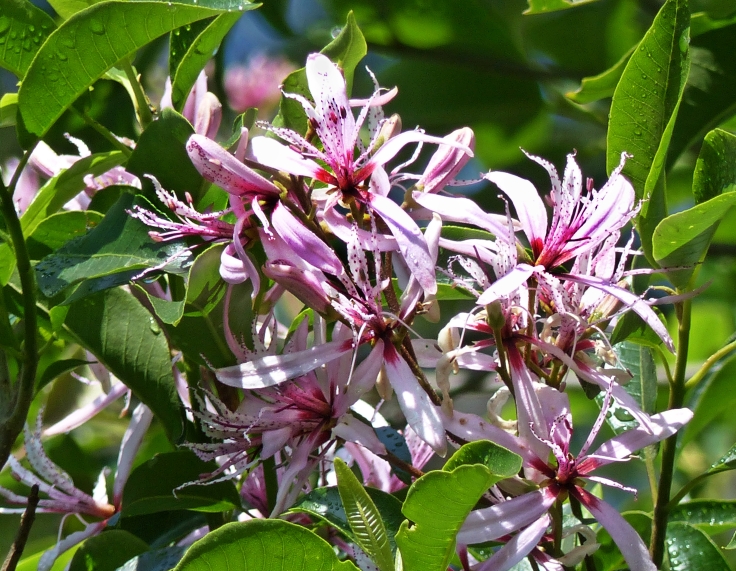
Typically the Cape chestnut has a high rounded crown, and I had to zoom in to get a close-up of the flowers that are high up in the tree at the bottom of our garden
The other common name for this tree is wild chestnut. It was named as a chestnut by William Burchell (1782-1863) because of similarities in flower and fruit to the horse chestnut that he was familiar with, although these trees are not related. Burchell was an English explorer, naturalist, artist and writer who’s travels included an expedition in South Africa when he collected over 50,000 mostly botanical specimens.
The botanical name Calodendrum capense means beautiful (kalos) tree (dendron) from the Cape (capense). Indeed it is a beautiful tree, and although it was named in the Cape by botanist Carl Peter Thunberg (1743-1828), it is not limited to the Cape and occurs across southern Africa and into tropical Africa as far north as Ethiopia.
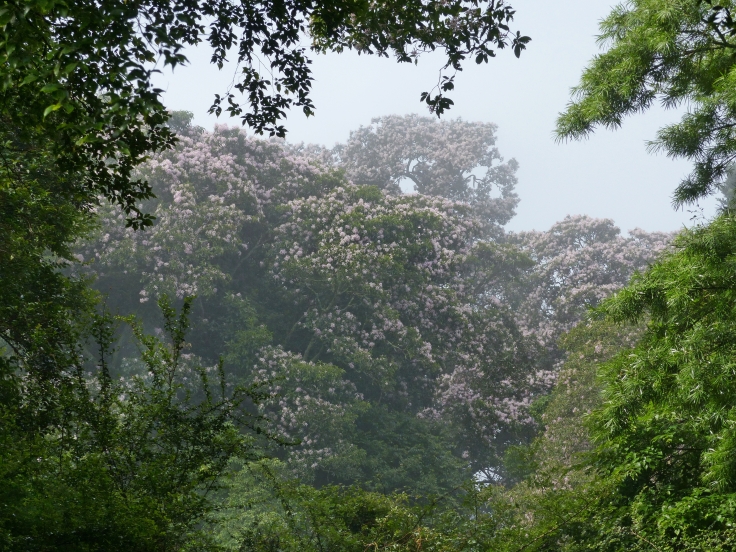
The Cape/wild chestnut is a tree of the forest. This photograph of Cape chestnut trees in flower was taken as the morning mist was dissipating in a patch of mistbelt forest next to farmland in the KwaZulu-Natal Midlands
The Cape chestnut is evergreen at the coast where conditions tend to be warmer all year round, and it is semi-deciduous to deciduous inland. The tree outside our garden sheds its leaves at the end of winter and the leaves start budding in the early spring. The leaves, typical of all Rutaceae (citrus) species, are dotted with oil glands. Consequently the leaves are aromatic when crushed exuding a soft almost lemony smell.
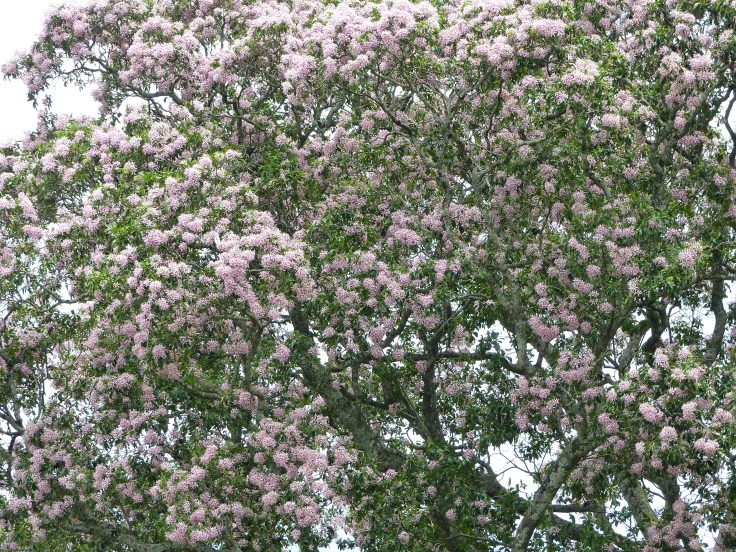
A mature Cape chestnut in full flower is a sight to see. This photograph was taken in the KwaZulu-Natal (KZN) Midlands

The Cape chestnut is known for its pink flowers, but some trees have white flowers. We came across only one tree with white flowers in a patch of mistbelt forest in the KZN Midlands
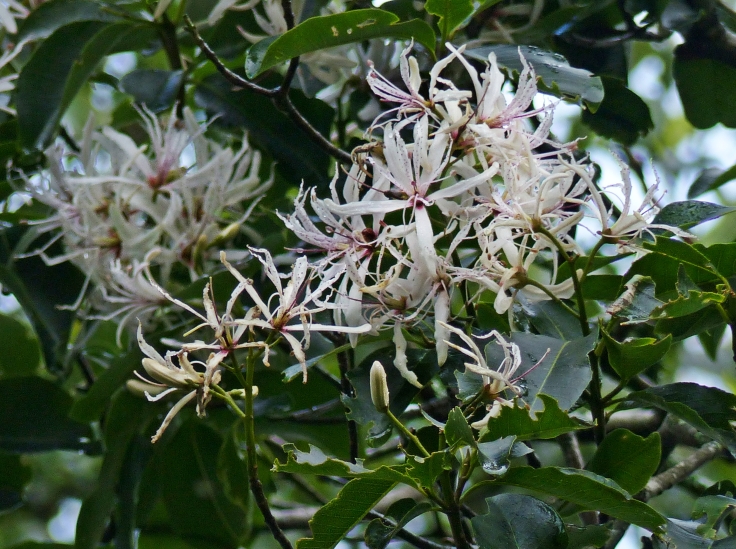
Looked at more closely, even the seemingly white flowers have pink centres
With a non-invasive root system and its attractive flowers, the Cape chestnut is used as a street tree and is popular in larger gardens. I gather it is sought after as an ornamental tree in other continents too, including Australia.
Its pale yellow hard wood is easily worked and has many uses, past and present, including tent bows, wagon-making, yokes, planking, shovel handles and furniture, and in the past at least was considered one of the most generally useful hard woods. It can also be used for firewood and to make charcoal.

The flowers attract insects including bees and butterflies, but apparently they do not attract birds
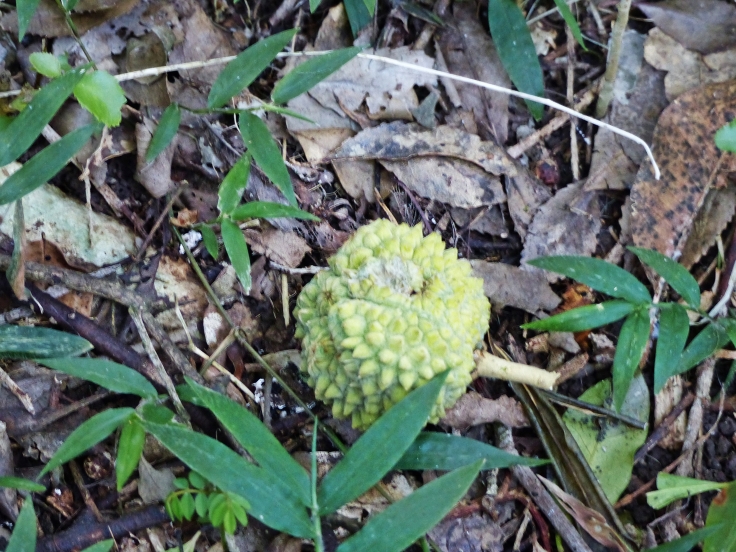
A green seed capsule of a Cape chestnut found on the floor of mistbelt forest in KZN
The seed capsule is woody and as it ripens it splits into five lobes and eventually spills its black seeds. The seeds are eaten by samango and vervet monkeys and also by African olive (formerly rameron) pigeons, lemon (formerly cinnamon) doves and by Cape parrots. When the black seed coverings are opened the kernels within are like pale nuts.
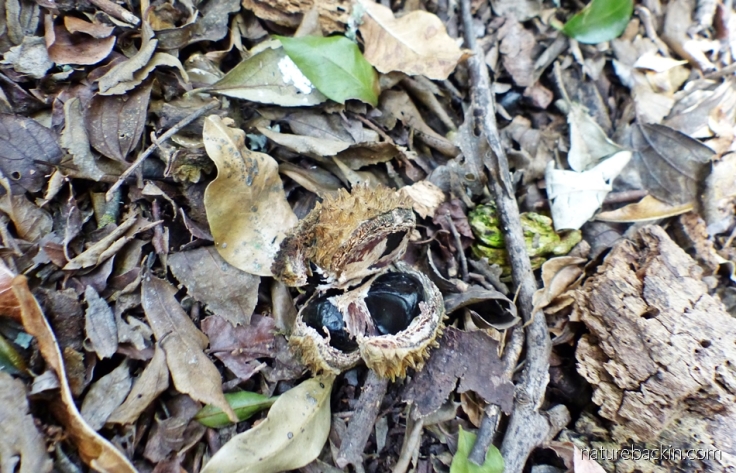
Lying on the forest floor, a ripe seed capsule that has split to reveal the black seeds within
The kernels can be crushed and boiled to make an oil that can be used to make soap. The oil is also used as a skin moisturiser known as yangu oil. The bark too is used as an ingredient for facial skin care.
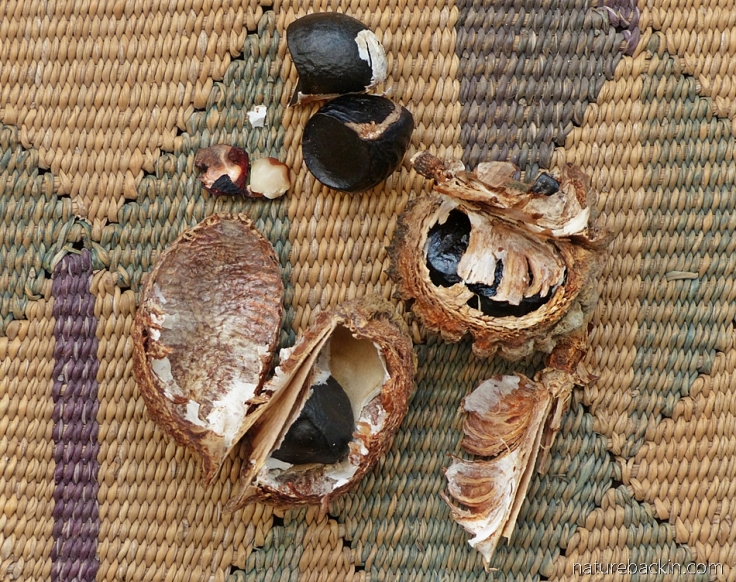
A seed capsule that I left outside (we were planning to plant the seeds), which was found and torn open by a vervet monkey. Fragments of kernel left by the monkey can be seen to the left of the two black seeds that have been released from the capsule. Vervet and samango monkeys play an important role as seed dispersers of many trees and other plants
Although the Cape chestnut is a larval host plant of the citrus swallowtail (Papilio demodocus) butterfly, I have not noticed the butterflies seeking out this tree in particular. What I did do though, was check up on the immature instar caterpillar on our potted lime tree. During the past week the caterpillar has moulted and in the process changed from black and white to the green colours of the mature caterpillar.

The citrus swallowtail caterpillar still in its early form last week
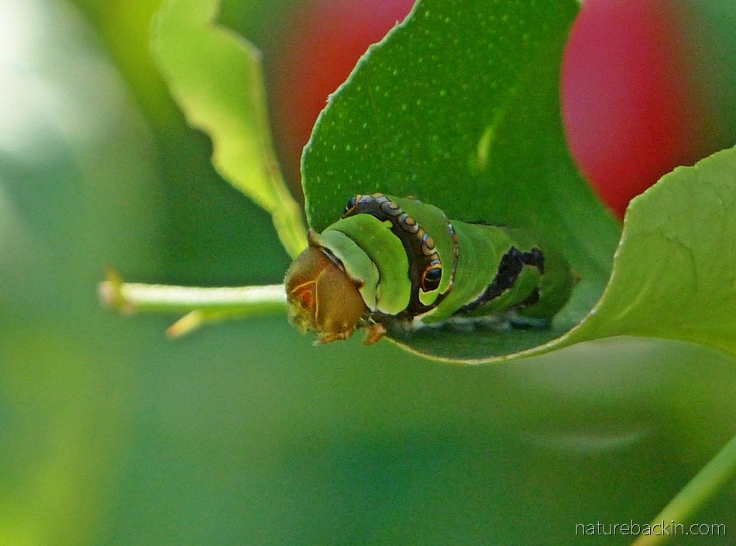
The same caterpillar in its next form (instar) two days later
The citrus swallowtail caterpillars take about 4 weeks to develop passing through 4 or 5 instars in the process. The mature caterpillar is around 45 mm (1.7 inches) in length. After shedding its skin (cuticle) it eats the shed cuticle, presumably for its nutritional value, before resuming leaf eating. The new cuticle has folds to allow for a degree of expansion as the caterpillar grows larger.
Despite its size the caterpillar is well camouflaged against the green leaves and can be quite difficult to see even when one has a general idea where it is. Today when I went out to look for it, I couldn’t find it. But yesterday I photographed it in the company of a grasshopper.

The grasshopper stretching its legs with the caterpillar visible in the background

The focus is switched onto the caterpillar, which is noticeably larger than it was only a few days before. The grasshopper is just visible out of focus in the foreground
Well, I have just been out again to look for the caterpillar, which I last saw last evening and I can’t spot it. I found a small grasshopper and a tiny jumping spider eating a fly but the caterpillar seems to be well hid. It is likely too soon for it to have pupated, and unless something unfortunate happened, I think it is concealed in a tangle of lime tree, cherry tomatoes and pepperdew plants. I hope so anyway.

Sources:
Fern, Ken. 2014. Calodendrum capense. Tropical Plants Database. http://tropical.theferns.info/viewtropical.php?id=Calodendrum+capense; Mackean, D G & Mackean Ian. 2004-2020. Papilio demodocus – the Citrus Swallowtail Butterfly. Resources for Biology Teaching by D G Mackean. http://www.biology-resources.com/insect-papilio-01.html; Notten, Alice. 2001. Calodendrum capense. South African National Biodiversity Institute (SANBI). PlantZAfrica.com http://pza.sanbi.org/calodendrum-capense; Robertson, Hamish. [n.d.] Papilio demodocus (Citrus swallowtail). Biodiversity Explorer. http://www.biodiversityexplorer.info/butterflies/papilionidae/papilio_demodocus.htm
Posted by Carol

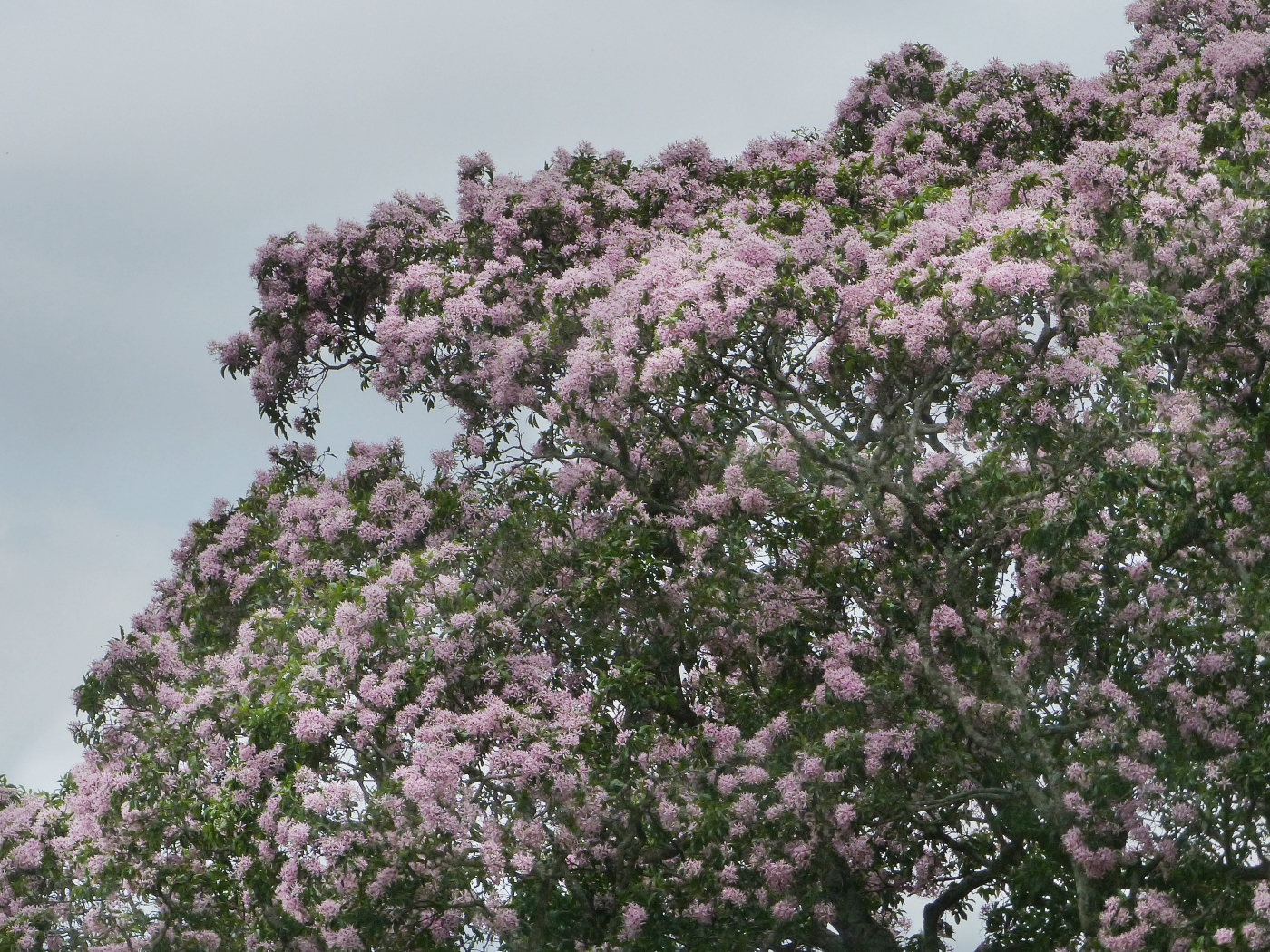




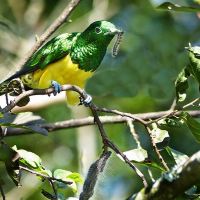
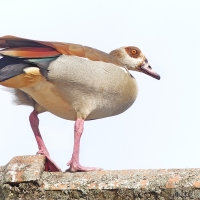

March 9, 2021 at 2:17 pm
Good day. How well would this species grow in the Cape peninsular?
LikeLiked by 1 person
March 11, 2021 at 11:10 am
Hi Fiona – Cape chestnuts do occur naturally in the Western Cape but in forested areas, ravines and riverine bush. So in a garden on the peninsula they would need a sheltered spot to protect them from the wind (esp when they are getting established) and also they may need extra watering in the summer. You might find this link useful https://cjmgrowers.co.za/calodendrum-capense/
LikeLike
April 28, 2020 at 6:48 pm
Thank you for introducing us to this amazing tree. We have swallowtail butterflies but nothing like these trees apart from our orchards of sweet chestnuts. You hardly notice the blossom! But you sure know about the thorny cases of the chestnut! Definitely a tropical beauty and love that it is a wild forest tree with all that nutrition for so many species!
LikeLiked by 1 person
April 28, 2020 at 9:02 pm
It is a spectacular tree. Natural forests here make up a tiny fraction of the total land space and various biomes, but where they are they incredibly rich.
LikeLiked by 1 person
March 16, 2020 at 3:34 am
Marvelous images and explanations, as always.
LikeLiked by 1 person
March 17, 2020 at 8:18 pm
Thanks so much Gunta.
LikeLike
March 15, 2020 at 8:57 am
We had one of these magnificent trees in our garden in the Eastern Cape when I was a child. Your post brought back such happy memories and, as always, was most informative.
LikeLiked by 1 person
March 17, 2020 at 8:17 pm
Thanks Christine. I am glad the post and the trees helped evoke happy childhood memories.
LikeLike
March 15, 2020 at 5:07 am
Loved reading this post Carol! Your photographs of this beautiful tree are phenomenal! Love the white flowering one, never knew that one found white ones although I am sure they can’t be common. It truly is the most beautiful tree. Thank you for sharing.
LikeLiked by 1 person
March 17, 2020 at 8:16 pm
Thanks Carol. That is the only white-flowering tree I have seen. It is lovely, but not quite as awesome as the pink.
LikeLiked by 1 person
March 14, 2020 at 2:41 pm
This is indeed a most beautiful tree. They are in flower in High Street in Grahamstown at the moment.
LikeLike
March 14, 2020 at 2:39 am
Carol your extensive research and excellent photos make this beautiful tree come ‘alive’, thank you! xxx
LikeLiked by 1 person
March 17, 2020 at 8:07 pm
Thanks Christeen. The trees really come into their own in their natural forest habitat.
LikeLiked by 1 person
March 14, 2020 at 1:39 am
What a wonderful treat to see these caterpillars so close up at the end of your post! However did you know exactly where to look?
LikeLiked by 1 person
March 17, 2020 at 8:06 pm
We have a potted lime tree (featured in the previous post too) and it is favoured by these butterflies, which is how I knew to look on this tree and found the caterpillar.
LikeLiked by 1 person
March 17, 2020 at 8:14 pm
Fabulous 😊
LikeLiked by 1 person
March 13, 2020 at 12:46 pm
A wonderful read! Grahamstown is awash with pink at the moment – Dais cotinifolia and Cape Chestnut trees. There are several of the latter around town and they are covered with blossoms.
LikeLiked by 1 person
March 17, 2020 at 8:03 pm
How lovely to have both flowering together. The flowers of both are very lovely. With your late rain the trees in your area are flowering much later than both trees flowered here,
LikeLike
March 13, 2020 at 10:34 am
Thanks again Carol, for this informative text and outstanding photographs!
LikeLiked by 1 person
March 17, 2020 at 8:01 pm
Thanks very much Suzette. The tree is a great subject 🙂
LikeLike
March 13, 2020 at 9:56 am
Yes, this is such a beautiful tree and there was one just down the road from us where we lived in Sydney. I’m afraid it’s just too frosty where we are now to grow one, but I remember seeing the Sydney one in full bloom. Gorgeous!
LikeLiked by 1 person
March 17, 2020 at 8:01 pm
How nice to see one in Sydney. I gather that if protected while they are getting a established they can withstand a small amount of frost thereafter, but I am sure you have many beautiful and more appropriate alternatives to choose from.
LikeLiked by 1 person
March 13, 2020 at 6:10 am
I’m glad your chestnut is not related to our varieties here. European tress have been subjected for several years now to a canker causing summer die back in the leaves, though they always appear normally healthy again by spring time. Luckily your caterpillars don’t have this to contend with. A lovely post as usual. Happy hunting!
LikeLiked by 1 person
March 17, 2020 at 7:58 pm
That is sad about the chestnut tree canker, It is hopeful that the trees at least survive, and lets hope the canker diminishes over time.
I have not been all that successful seeing the caterpillar since last posting, but I have seen it again and am hoping it is still around.
LikeLiked by 1 person
March 18, 2020 at 8:05 am
Keep sleuthing! And yes, horrible as the canker is, the trees seem to come back for more every spring.
LikeLiked by 1 person
March 13, 2020 at 5:59 am
What a lovely tree. As you say, a sight to see when in bloom. The photo of the seed capsules made me think of conkers (from horse chestnuts) for the first time in donkey’s years.
I hope the caterpillar is Ok and that you get to follow it through its various stages of development.
LikeLiked by 1 person
March 17, 2020 at 7:54 pm
Yes, you can see why it was called a chestnut because of its resemblance to horse chestnuts. I recall conkers from when I was at school in the UK for a short time as a child.
I have seen the caterpillar again but it has quite a bit of vegetation to hide in and so it will be difficult to keep an eye on it as it develops. That might be a shame, but it has a better chance of not being eaten perhaps.
LikeLiked by 1 person
March 13, 2020 at 3:33 am
Thank you for my Friday-morning fix, Carol, and what a special treat it is – AGAIN!
The Cape Chestnut really is beautiful, and especially so in its preferred forest habitat. Just looking at your pictures has me hearing samango monkeys calling.
I sincerely hope the caterpillar hasn’t metamorphosized into agama food…
LikeLiked by 1 person
March 17, 2020 at 7:51 pm
Thanks so much Dries 🙂
I like that you associate the Cape chestnut with the calling of samangos.
I have seen the caterpillar again and this one seems better at hiding than its predecessor and so maybe it will avoid such an untimely metamorphosis into agama food!
LikeLiked by 1 person
March 12, 2020 at 7:57 pm
What a gorgeous tree. Wish we had one in our garden.
We have five fully grown lemon trees and a bitter orange tree on the property that attract the citrus swallowtail.
I have collected around 10 caterpillars over the past 12 months and ”raised them” to butterflies. It has been fascinating.
I read a while back they will also lay eggs on rue and once encountered a caterpillar on a plant in the back garden.
LikeLiked by 1 person
March 12, 2020 at 8:18 pm
How amazing to collect and help raise the caterpillars. It must be interesting to observe their progress.
I think that rue is also a member of the Rutaceae (citrus) family although it seems somewhat surprising.
LikeLiked by 1 person
March 12, 2020 at 7:20 pm
What a beautiful and useful tree. It’s form is lovely.
That larva has excellent camouflage, I hope it is safely hiding out somewhere and will live to become a beautiful butterfly.
LikeLike